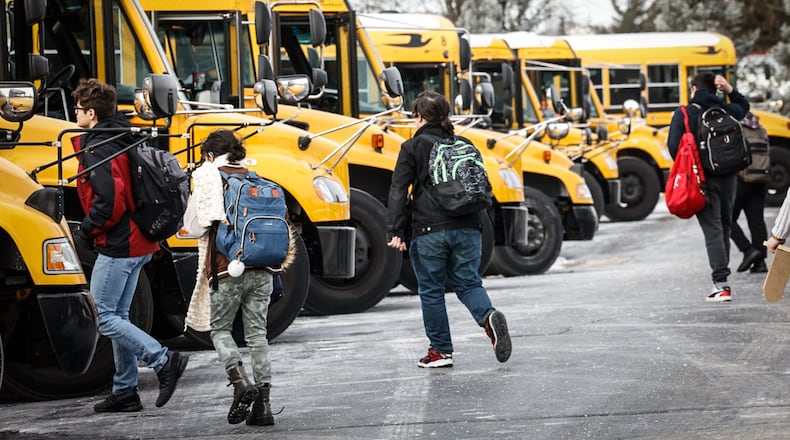The 176 comments on Kettering schools’ Facebook post announcing a two-hour delay Wednesday certainly illustrated that. Posts complaining that kids were being overly coddled by closures and delays were side-by-side with parents talking about frostbite risks and students falling on ice.
Some districts — Dayton Public, Fairborn, Northridge, Trotwood and Valley View among them — chose to close for the day Wednesday. Significantly more opted to operate on a two-hour delay, including Beavercreek, Centerville, Huber Heights, Kettering, Northmont, Oakwood, Troy and Xenia.
Districts that closed said they gave students the day off rather than asking them to do remote learning.
Each district has its own policy and decision point, and school administrators said there are multiple factors used to reach a conclusion. But districts that responded to a Dayton Daily News survey Wednesday said the wind chill played a large factor in their decision making, along with the desire to keep students safe.
“For cold weather, we have a rough idea, such as when the wind chill reaches a certain amount, but we don’t have a set figure, as we also look at the possibility of temperatures rising throughout the morning, particularly if we issue a 2-hour delay,” said David Fong, a spokesman for Troy City Schools.
The timing of the decision creates challenges for every household, which have unique needs, Kettering Superintendent Mindy McCarty-Stewart said.
“There is no perfect formula in making decisions to delay or close school,” she said in the survey response. “It is difficult to put a number to the ‘amount’ of snow or a specific temperature that would prompt me to delay or close school.
“The decision to delay or close school depends on whether we can safely transport students to school and the threshold of safety when it comes to frigid temperatures and students who may be waiting at bus stops or walking to school,” Mindy McCarty-Stewart added. “Each situation brings its own unique variables that go into making a decision that is in the best interest of our students.”
Dayton Public officials decided on a range of temperatures that would make it difficult for Dayton students to come to school, DPS interim superintendent David Lawrence said at Tuesday night’s school board meeting. The wind chills Wednesday morning fell within the range, so the district closed for the day and let families and students know ahead of time Tuesday afternoon.
Schools said student safety is most important. Jason Enix, superintendent of Huber Heights schools, noted the temperatures Wednesday morning put students at risk for frostbite.
Credit: Bill Lackey
Credit: Bill Lackey
“Wind chill values, as determined by NOAA and other weather organizations, designate the time for hypothermia and/or frostbite to occur when skin is exposed,” he said in the survey. “This factors into the safety of students, especially with the distances that some students are required to walk to school, wait outside if dropped off at a building before it is open, or even waiting at a bus stop if there are delays.”
If conditions are uncertain the night before, districts said they seek to announce a decision to close or delay by 6 a.m. — if not before — by contacting the media, using their own digital and social media platforms, and sending phone/text alerts.
But when school is canceled late, families may struggle to find childcare, especially when it causes them to juggle their plans.
“We understand these decisions impact our families and strive to make these decisions as early as we can,” Beavercreek spokeswoman Anaka Rettig said in the survey. “Our decision-making process involves closely monitoring weather forecasts, considering the condition of roads, and how things affect our transportation department.”
The ability for buses to traverse the roads, Mad River Superintendent Chad Wyen said, requires communication with the city of Riverside on the progress of crews plowing streets.
Wyen said he is also “in constant communication with a group of superintendents” from northern Montgomery County, as well as Beavercreek and Fairborn schools which — like Mad River — border Wright-Patterson Air Force Base.
Some districts, such as Fairborn and Northmont, encourage families to plan for childcare when school is called off.
“We know it’s a hassle for families, but we also know that in Ohio, weather can be a factor during the winter,” Northmont spokeswoman Jenny Wood said. “We send a letter to parents (that is also posted on our website) in October to remind them to have a back-up plan in the case of bad weather.”
While the COVID-19 pandemic forced schools to adapt to remote learning, few local schools ask students to log in when the district is unexpectedly closed. That’s because the districts know the students may not have access to a device they can do schoolwork on, may not have reliable internet service, and teachers may not have a remote-friendly plan for that day.
“Most of the time, unless we have plenty of time to prepare, the students and teachers might not have the resources at home to participate in remote learning,” said David Vail, superintendent of Carlisle Local Schools.
“In order to make that productive, the lesson needs to be pertinent to what is currently being taught in the classroom, which is not always the case when it is impromptu or unannounced,” he added.



